Related Research Articles

Little Turtle was a Sagamore (chief) of the Miami people, who became one of the most famous Native American military leaders. Historian Wiley Sword calls him "perhaps the most capable Indian leader then in the Northwest Territory," although he later signed several treaties ceding land, which caused him to lose his leader status during the battles which became a prelude to the War of 1812. In the 1790s, Mihšihkinaahkwa led a confederation of native warriors to several major victories against U.S. forces in the Northwest Indian Wars, sometimes called "Little Turtle's War", particularly St. Clair's defeat in 1791, wherein the confederation defeated General Arthur St. Clair, who lost 900 men in the most decisive loss by the U.S. Army against Native American forces.

The Miami are a Native American nation originally speaking one of the Algonquian languages. Among the peoples known as the Great Lakes tribes, they occupied territory that is now identified as North-central Indiana, southwest Michigan, and western Ohio. The Miami were historically made up of several prominent subgroups, including the Piankeshaw, Wea, Pepikokia, Kilatika, Mengakonkia, and Atchakangouen. In modern times, Miami is used more specifically to refer to the Atchakangouen. By 1846, most of the Miami had been forcefully displaced to Indian Territory. The Miami Tribe of Oklahoma are the federally recognized tribe of Miami Indians in the United States. The Miami Nation of Indiana, a nonprofit organization of descendants of Miamis who were exempted from removal, have unsuccessfully sought separate recognition.

The Fort Wayne Old City Hall Building in downtown Fort Wayne, Indiana operates as a museum known as The History Center, and has served as headquarters for the Allen County–Fort Wayne Historical Society since 1980. The Richardsonian Romanesque style sandstone building was designed by the architectural firm Wing & Mahurin and built in 1893. It served as a functioning city hall for the city until 1971 when local officials moved to the City-County Building.

Tecumseh's War or Tecumseh's Rebellion was a conflict between the United States and Tecumseh's Confederacy, led by the Shawnee leader Tecumseh in the Indiana Territory. Although the war is often considered to have climaxed with William Henry Harrison's victory at the Battle of Tippecanoe in 1811, Tecumseh's War essentially continued into the War of 1812 and is frequently considered a part of that larger struggle. The war lasted for two more years, until 1813, when Tecumseh and his second-in-command, Roundhead, died fighting Harrison's Army of the Northwest at the Battle of the Thames in Upper Canada, near present-day Chatham, Ontario, and his confederacy disintegrated. Tecumseh's War is viewed by some academic historians as the final conflict of a longer-term military struggle for control of the Great Lakes region of North America, encompassing a number of wars over several generations, referred to as the Sixty Years' War.

Tenskwatawa was a Native American religious and political leader of the Shawnee tribe, known as the Prophet or the Shawnee Prophet. He was a younger brother of Tecumseh, a leader of the Shawnee. In his early years Tenskwatawa was given the name Lalawethika, but he changed it around 1805 and transformed himself from a hapless, alcoholic youth into an influential spiritual leader. Tenskwatawa denounced the Americans, calling them the offspring of the Evil Spirit, and led a purification movement that promoted unity among the Indigenous peoples of North America, rejected acculturation to the American way of life, and encouraged his followers to pursue traditional ways.
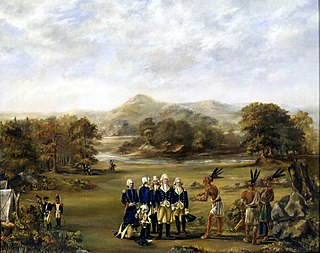
The Northwest Indian War (1785–1795), also known as the Ohio War, Little Turtle's War, and by other names, was a war between the United States and the Northwestern Confederacy, with support from the British, for control of the Northwest Territory. It followed centuries of conflict over this territory, first among Native American tribes, and then with the added shifting alliances among the tribes and the European powers of France and Great Britain, and their colonials. The United States would inherit these conflicts after their independence secured. The United States Army considers it their first of the United States Indian Wars.
Kekionga, also known as Kiskakon or Pacan's Village, was the capital of the Miami tribe. It was located at the confluence of the Saint Joseph and Saint Marys rivers to form the Maumee River on the western edge of the Great Black Swamp in present-day Indiana. Over their respective decades of influence from colonial times to after the American Revolution and Northwest Indian Wars, the French, British and Americans all established trading posts and forts at the large village, as it was located on an important portage connecting Lake Erie to the Wabash and Mississippi rivers. The European-American town of Fort Wayne, Indiana started as a settlement around the American Fort Wayne stockade after the War of 1812.
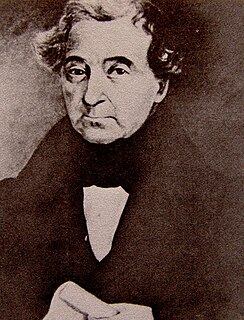
Jean Baptiste de Richardville, also known as Pinšiwa or Peshewa in the Miami-Illinois language or John Richardville in English, was the last akima 'civil chief' of the Miami people. He began his career in the 1790s as a fur trader who controlled an important portage connecting the Maumee River to the Little River in what became the present-day state of Indiana. Richardville emerged a principal chief in 1816 and remained a leader of the Miamis until his death in 1841. He was a signatory to the Treaty of Greenville (1795), as well as several later treaties between the U.S. government and the Miami people, most notably the Treaty of Fort Wayne (1803), the Treaty of Fort Wayne (1809), the Treaty of Saint Mary's (1818), the Treaty of Mississinewas (1826), the treaty signed at the Forks of the Wabash (1838), and the Treaty of the Wabash (1840).

William Wells, also known as Apekonit, was the son-in-law of Chief Little Turtle of the Miami. He fought for the Miami in the Northwest Indian War. During the course of that war, he became a United States Army officer, and also served in the War of 1812.

The Treaty of Fort Wayne, sometimes called the Ten O'clock Line Treaty or the Twelve Mile Line Treaty, is an 1809 treaty that obtained 29,719,530 acres Native American land for the settlers of Illinois and Indiana. The negotiations primarily involved the Delaware tribe but included other tribes as well. However, the negotiations excluded the Shawnee, who were minor inhabitants of the area and had previously been asked to leave by Miami War Chief Little Turtle. Territorial Governor William Henry Harrison negotiated the treaty with the tribes. The treaty led to a war with the United States begun by Shawnee leader Tecumseh and other dissenting tribesmen in what came to be called "Tecumseh's War".

Augustin Mottin de la Balme was a French cavalry officer who served in Europe during the Seven Years' War and in the United States during the American Revolution. His attempt to capture Fort Detroit in 1780 ended in defeat when he was ambushed by forces under Chief Little Turtle.
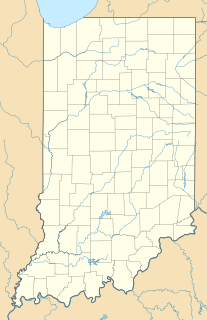
Ouiatenon was a dwelling place of members of the Wea tribe of Native Americans. The name Ouiatenon, also variously given as Ouiatanon, Oujatanon, Ouiatano or other similar forms, is a French rendering of a term from the Wea dialect of the Miami-Illinois language which means "place of the people of the whirlpool", an ethnonym for the Wea. Ouiatenon can be said to refer generally to any settlement of Wea or to their tribal lands as a whole, though the name is most frequently used to refer to a group of extinct settlements situated together along the Wabash River in what is now western Tippecanoe County, Indiana.
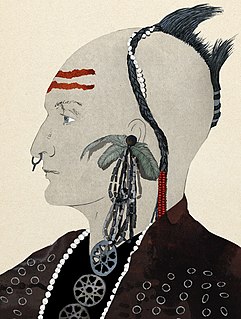
Pacanne was a leading Miami chief during the late 18th and early 19th centuries. Son of The Turtle (Aquenackqua), he was the brother of Tacumwah, who was the mother of Chief Jean Baptiste Richardville. Their family owned and controlled the Long Portage, an 8-mile strip of land between the Maumee and Wabash Rivers used by traders travelling between Canada and Louisiana. As such, they were one of the most influential families of Kekionga.
In 1802, during a trip to Washington, DC, Miami Chief Little Turtle extended an invitation to the Baltimore area Quakers to visit Fort Wayne and teach the Miami about white civilization and European cultivation methods. The Quakers sent farm implements in 1803. Little Turtle, by way of William Wells, sent a letter thanking them for the tools, but expressed uncertainty of how they should be used.
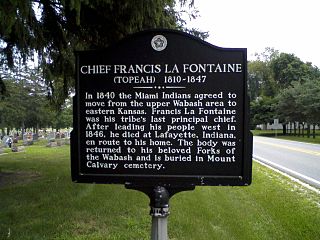
Francis La Fontaine, or Topeah or Me-Shine-go-me-she-a, was the last principal chief of the unified Miami tribe, and oversaw the split into the Western and Eastern Miami tribes.

The Harmar campaign was an Autumn 1790 attempt by the United States to subdue Native Americans nations in the Northwest Territory that were seen as hostile. The campaign was led by General Josiah Harmar, and is considered a significant campaign of the Northwest Indian War. The campaign ended with a series of battles from 19–21 October 1790 near the Miami villages of Kekionga. These were all overwhelming victories for the Native Americans, and are sometimes collectively referred to as Harmar's Defeat.
Five Medals was a leader of the Elkhart River Potawatomi. He led his people in defense of their homelands and was a proponent of agriculture. Five Medals first appeared in eastern records after the Battle of Fallen Timbers, but disappears from those records shortly after the end of the War of 1812.
Cold Foot was a Miami chief in the 18th century; his brother or brother-in-law was The Turtle (Aquenackqua), father of Cold Foot's nephew, P'koum-kwa and of P'koum-kwa's sister, Tacumwah, who became the wife of a French fur trader and the mother of Chief Peshewa. Their family owned and controlled the Long Portage, an 8-mile strip of land between the Maumee and Wabash Rivers used by traders travelling between Canada and Louisiana. An inhabitant of Kekionga, Cold Foot lived during a time when the Miami were torn between their traditional trading partners of New France and new, more lucrative traders from the British colonies. There is a record of Cold Foot receiving a large reward for putting down some hostilities during this time.

LaBalme's Defeat was a short but decisive battle on 5 November 1780 between French colonials in Illinois Country led by French cavalry officer Augustin de La Balme and Miami forces under the leadership of Little Turtle (Mihšihkinaahkwa). The target of LaBalme was British occupied Fort Detroit, but after he sacked the large Miami town of Kekionga, the Miami enacted their revenge. The victory gained notoriety for Little Turtle, who would become one of the most successful Native American military commanders to engage with the United States Army.
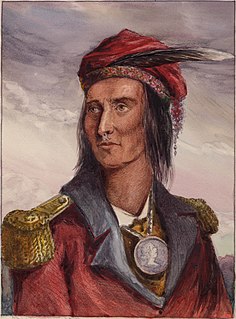
Tecumseh's confederacy was a confederation of native Americans in the Great Lakes region of the United States that began to form in the early 19th century around the teaching of Tenskwatawa. The confederation grew over several years and came to include several thousand warriors. Shawnee leader Tecumseh, the brother of The Prophet, developed into the leader of the group as early as 1808. Together, they worked to unite the various tribes against the European settlers coming across the Appalachian Mountains and onto their land. In November 1811, an American military force under the leadership of William Henry Harrison engaged warriors associated with Tenskwatawa in the Battle of Tippecanoe. Under Tecumseh's leadership, the confederation then went to war with the United States during Tecumseh's War and the War of 1812. However, the confederation fell apart in 1813 following his death at the Battle of the Thames.
References
- ↑ Carter, pg 65-66
- ↑ Carter, 66
- ↑ Anson, 104
- ↑ Carter, 77
- ↑ Cayton, 87
- ↑ Carter, 146. See Text of the Treaty of Greenville Archived 2008-03-15 at the Wayback Machine
- ↑ Allison, pg 294
- Allison, Harold (1986). The Tragic Saga of the Indiana Indians. Turner Publishing Company, Paducah. Graphic Design of Indiana. ISBN 0-938021-07-9.
- Anson, Bert. The Miami Indians. ©2000. University of Oklahoma Press. ISBN 0-8061-3197-7.
- Carter, Harvey Lewis. The Life and Times of Little Turtle: First Sagamore of the Wabash. Urbana: University of Illinois Press, 1987. ISBN 0-252-01318-2.
- Cayton, Andrew R. Frontier Indiana 1998, Indiana University Press. ISBN 0-253-21217-0
- Text of the Treaty of Greenville